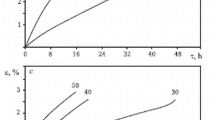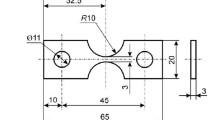Abstract
X-ray diffraction analysis is used to study changes in the phase composition and domain structure of a ferroelectric ceramic of the CTS system during highfrequency cyclic deformation. It is found that these microstructural processes take place mainly during the initial stages of fatiguedamage accumulation. Correlation of the empirical data with specific energy dissipation makes it possible to establish the phenomenological pattern of the fatigue process in materials of the given class.
Similar content being viewed by others
Literature cited
B. Jaffe, U. Cook, and G. Jaffe, Piezoelectric Ceramics [Russian translation], Mir, Moscow (1974).
V. A. Isupov, “Explanation of inconsistencies regarding the multiphase region in solid solutions of lead zirconatetitanate,” Fiz. Tverd. Tela,22, No. 1, 172–177 (1980).
V. A. Isupov, “Piezoelectric ceramics,” All-Republic Inter-Institute Scientific-Technical Symposium, No. 13, 14–28 (1978).
A. A. Grekov, N. Ya. Egorov, and D. N. Karpinskii, “Induction of phase transformations during the fracture of ferroelectric ceramics,” in: Strength of Materials and Structural Elements at Sonic and Ultrasonic Loading Frequencies. Materials of an International Symposium, Naukova Dumka, Kiev (1986), pp. 187–192.
V. G. Gavrilyachenko, A. Ya. Dantsiger, V. A. Doroshenko, et. al, “Increasing the fatigue strength of piezoelectric ceramics,” in: Strength of Materials and Structural Elements at Sonic and Ultrasonic Loading Frequencies — Documents of the Second All-Union Seminar, Naukova Dumka, Kiev (1980), pp. 194–199.
G. G. Pisarenko, Strength of Piezoelectric Ceramics [in Russian], Naukova Dumka, Kiev (1987).
E. G. Fesenko, A. Ya. Dantsiger, and O. N. Razumovskaya, New Piezoelectric Ceramics [in Russian], Rost. Unta, Rostov-on-the-Don (1983).
V. M. Avdokhina, D. Botsur', V. V. Zubenko, et al., X-Ray Diffraction. Special Practicum [in Russian], Moscow Univ. (1986).
E. G. Fesenko, A. Ya. Dantsiger, V. Z. Borodin, and A. V. Turik, Polarization of Piezoelectric Ceramics [in Russian], Rost. Un-ta, Rostov-on-the-Don (1968).
V. V. Firsov, A. N. Negovskii, G. G. Pisarenko, et al., “Study of the damage mechanism in ferroelectric ceramics subjected to mechanical loading,” Probl. Prochn., No. 10, 56–59 (1990).
V. A. Freimanis, “Features of the structure of solid solutions based on lead titanate-zirconate and lead-barium metaniobate near the morphotropic phase boundary,” Author's Abstract of Physico-Mathematical Sciences Candidate Dissertation, Salaspils (1980).
A. V. Turin and A. I. Chernobabov, “Internal mechanical stresses and strength of ferroelectric ceramics,” Zh. Tekh. Fiz.,49, No. 8, 1732–1736 (1979).
Author information
Authors and Affiliations
Additional information
Translated from Problemy Prochnosti, No. 4, pp. 29–33, April, 1993.
Rights and permissions
About this article
Cite this article
Kovalev, S.P., Pisarenko, G.G., Firsov, V.V. et al. Effect of cyclic loading on the structural characteristics of ferroelectric ceramics. Strength Mater 25, 257–260 (1993). https://doi.org/10.1007/BF00776948
Received:
Issue Date:
DOI: https://doi.org/10.1007/BF00776948




